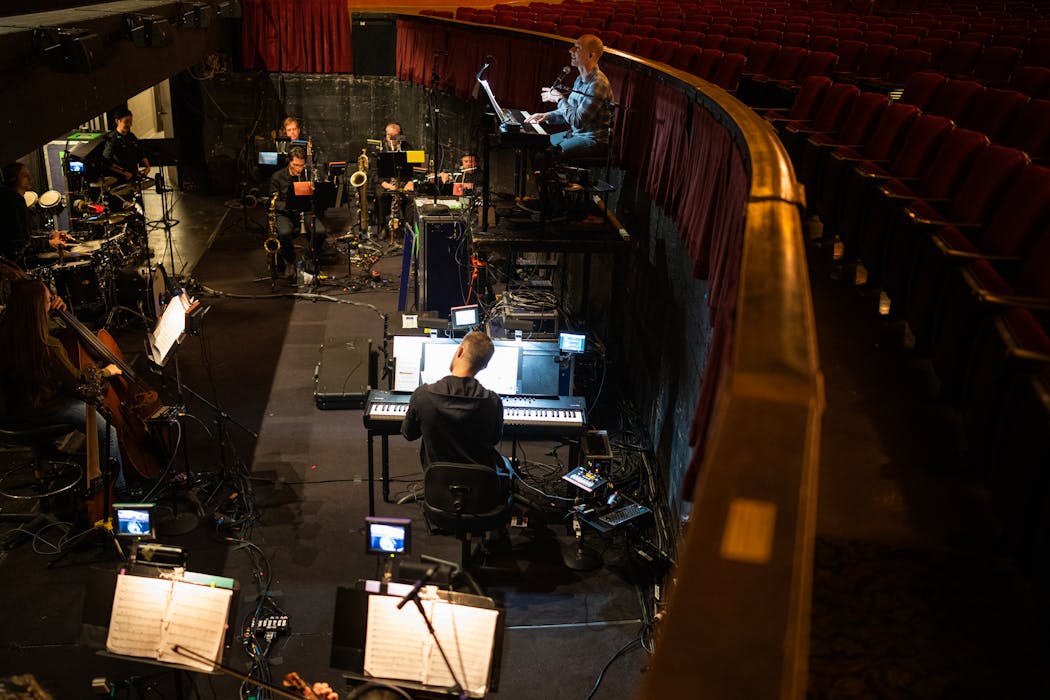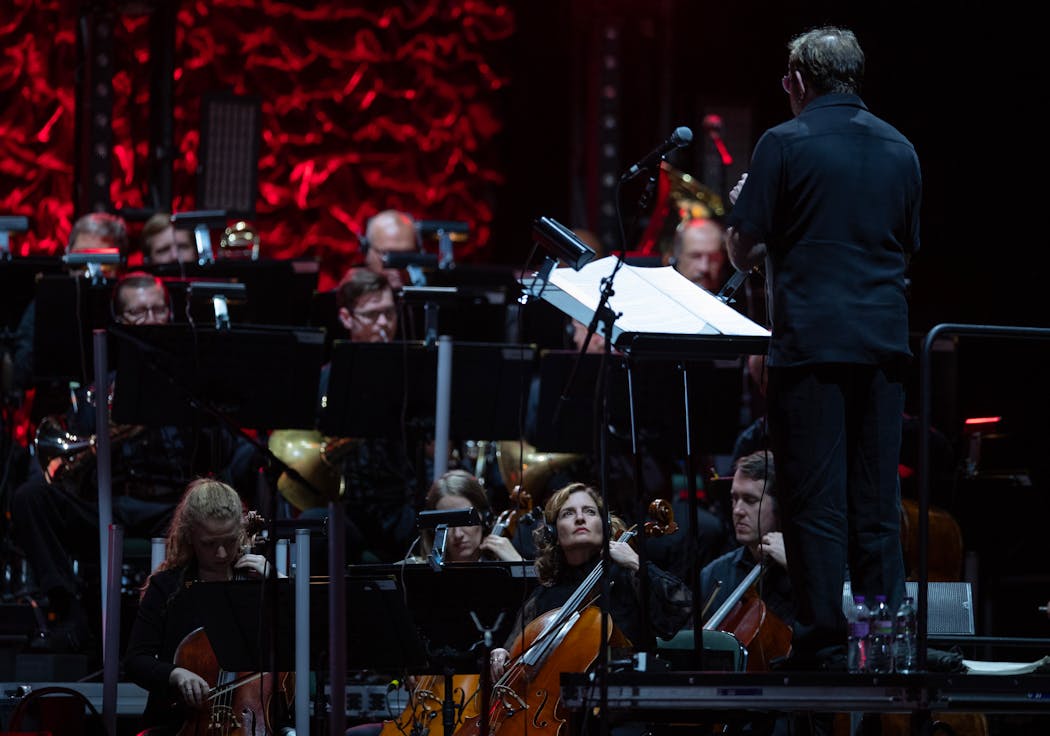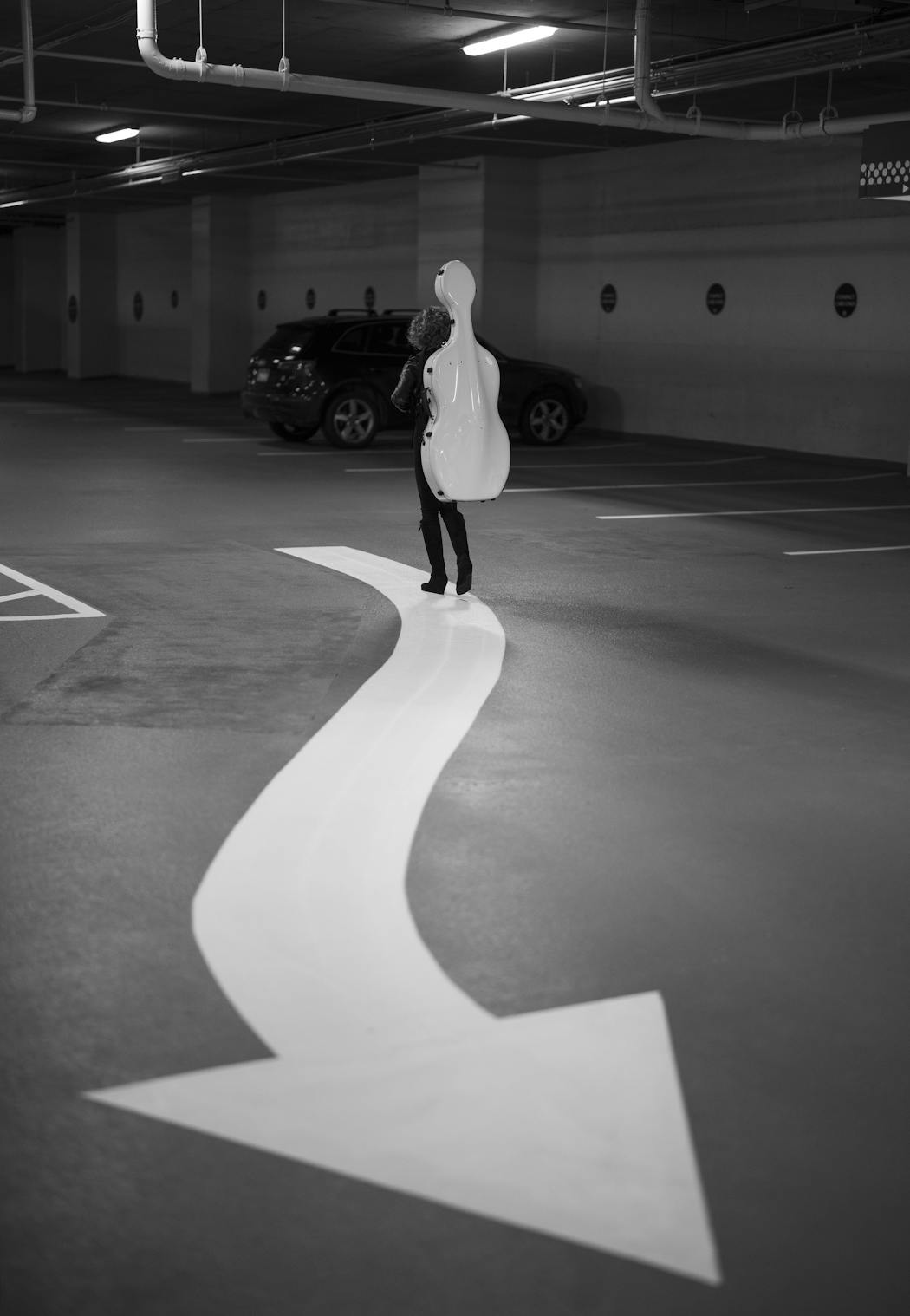We go into the orchestra pit with Minnesota musicians who play for touring musicals and rock bands
Various electrical cords — black ones, white ones, orange ones — are stretched across the bright floral-patterned rug. Coats and backpacks are scattered about the floor, too. The cords power the small lights on the music stands in the balcony lobby of Minneapolis' Orpheum Theatre.
An orchestra — all 10 musicians — is rehearsing here for the opening performance of the Broadway musical "Company."
"This is a bizarre show that doesn't start with music," conductor Charlie Alterman tells his players. "The overture comes three minutes into the show."
The musicians are on the clock in the cramped, dimly lit balcony lobby. It's 10 a.m. and in the next four hours, Alterman will guide them through 17 songs and many musical interludes for the 2 ½-hour show.
Rebecca Arons has spent months preparing for this moment.
She is the Twin Cities contractor who hires and distributes checks to the local musicians. She does it for musicals like "Company" and this week's "Funny Girl," for concerts by the likes of the Who and Ed Sheeran, and for dance performances like next month's Les Grands Ballets Canadiens.
Arons is part personnel director, part business manager, part union-rules expert, part spreadsheet wizard, part negotiator, part librarian, part networker, part communicator and part den mother. She's also one of the busiest freelance cellists in the Twin Cities.
"A story my mother used to tell was that when I was 3, my maternal great-grandmother said, 'There isn't any grass going to be growing under her feet,' " Arons recalls with a smile.
To get ready for "Company," six local musicians have done their homework. That's imperative as they mix with four traveling players, who have nearly perfected the score.
Violinist Maisie Block, a Twin Cities native with 20 years of professional experience, figures she spent seven to nine hours studying the "Company" score and a "conductor cam" video of Alterman, who also doubles as pianist, at work.
"That's a pretty intense schedule — a four-hour rehearsal, a tiny break, a soundcheck and then play the show," she says. "As far as I know, that's not how they do things at the Minnesota Orchestra and the St. Paul Chamber Orchestra."
Saxophonist/flutist Kenni Holmen has been gigging for 40 years, playing behind Tony Bennett and Tom Jones, among others, and touring with Prince and Cory Wong. When hired by Arons, he often gets paid extra per union rules because he's playing multiple reed and wind instruments. For "Company," he prepped two to three hours a day for a couple to three weeks.
It's worth it.
"In Minneapolis, the players are extraordinary," Alterman, who has taken three touring musicals to the Twin Cities, says in a post-rehearsal interview. "I remember that from my last time, as well."
The motormouth music director keeps his spirits high during rehearsal, often praising the players as he mainlines throat lozenges.
"The compliments are genuine," he points out. "I want them to be relaxed, because people do better work when they're relaxed."
Opening day of a touring musical is an extremely long one — 12-plus hours — for the musicians. After the rehearsal, they get a nearly three-hour break. Arons takes her dog for a walk around a Minneapolis lake. Block zooms to Plymouth to hang out with her two young sons and "reset." Holmen prefers to stay and explore the bowels of the Orpheum, which has all kinds of memorabilia dating back to its vaudeville days.
At 5 p.m., the musicians report to the Orpheum's orchestra pit for soundcheck — first with their own equipment, then with the principal singers.
Alterman is pleased. "Thank you, you all," he declares at 6:30 p.m. before running over to Chipotle for takeout. "Let's have an amazing show."
The Eagles to Andrea Bocelli
Born in Boston and raised in Amherst, Mass., Arons, 54, started cello lessons at age 7. There is musical DNA in the family: Her St. Paul-reared social worker mother was an amateur singer, her college professor father was an amateur jazz drummer whose mother was a concert pianist and whose dad was a professional clarinetist. Arons' younger brother is a drummer and recording engineer.
Music became Arons' life.
After earning a degree in cello and environmental studies at Oberlin College in Ohio, she headed to the University of Minnesota in 1991 for music graduate school. While studying, she landed a job in a string quartet, joined the Minnesota Opera orchestra and kept getting other gigs. Target commercials, teaching at the University of St. Thomas, the pit orchestra for touring musicals.
She was in the orchestra for "The Lion King" when it premiered at the Orpheum in Minneapolis in 1997 — and was flown to New York to participate in the original cast recording. Prince enlisted her to add strings to his 2015 song "Baltimore." And she's performed with a range of pop stars from Josh Groban and Stevie Wonder to Mannheim Steamroller and Celtic Woman.
"She's comfortable in classical music as well as various areas of pop," says Twin Cities pianist/arranger/producer Adi Yeshaya, who is Arons' partner in their creative company STRINGenius. "She's very good with collaboration — and details."
Alterman raved about Arons as a contractor.
"She's one of the really exceptional ones," said the itinerant music director. "She's great with communication. She's good at calm under pressure and keeping a smile and a good attitude. She's very pragmatic, and she's got very good taste in players."
High-energy but not high-strung, the driven Arons is also a marathon runner, mother of two sons at college in Ohio and New York, and an activist, serving as executive director of environmentally conscious Smart Growth Minneapolis. But music occupies most of her time. The contracting is demanding work.
A contractor since 1998 who took on Broadway touring shows in 2013, Arons has about 500 names in her contacts list, about 350 of whom are orchestra players.
She has to know her musicians — who's on time, prepared, reliable, presentable, adaptable to different styles of music — and plays well with others, literally and figuratively.
Typically, Arons receives several months' notice with requirements for players for a touring musical. Gigs with touring rock and pop stars provide less warning. Arons puts together a budget and proposal. And then comes the recruiting.
In the three days after Christmas, she had 353 pieces of correspondence — texts, emails or phone calls — to assemble two large orchestras for upcoming dance concerts — 52 pieces for Les Grands Ballets Canadiens and 32 players for the World Ballet Series — as well as another large ensemble for the "Batman 1989" concert at the Orpheum.
Despite adding envied lines on a resume, sharing the stage with the Eagles for "Hotel California" isn't necessarily glamorous. Seldom do orchestral musicians actually meet the stars. With a few exceptions.
The local musicians had dinner with Hugh Jackman before their concert at Xcel Energy Center. Violinist Block was thrilled to meet Soul Asylum's Dave Pirner — her sister's favorite rock star — at rehearsal when she accompanied the Minneapolis band for its unplugged concert last spring.
When pop superstar Sheeran enlisted five local string players, including Arons and Block, to join him for an intimate show at the State Theatre in August, he not only took photos with them but he sent them thank-you emails afterward.
Fun? Yes. Rewarding? For sure. Stressful? Often.
Nothing more so than the Andrea Bocelli concert last May. Not only did Arons have to recruit a 69-piece orchestra and hire the 60-voice Minnesota Chorale, but she had to find an advance rehearsal space for the orchestra as well as rent drums and a special electric keyboard. But the wrong keyboard showed up at Target Center for the day-of-show rehearsal. After a frantic phone call by Arons, the right one was delivered.
"We then had an issue turning it on," she remembered. "With three minutes to spare — and an understandably concerned conductor — that was sorted out. I had some deep breathing to do before the downbeat of 'Carmina Burana.' "
In the pit
It's 7:28 p.m. and "Mrs. Doubtfire" musical director Mark Binns ducks out of the Orpheum orchestra pit to change into a casual all-black outfit. He re-emerges and climbs a bright orange stepladder to a platform at the top of pit, which is littered with colorful confetti from the day's matinee.
At 7:35, he speaks into his microphone to his black-clad musicians: "Hey, friends, it's time. We're standing by. Let's have a good one. ... All right, here we go."
There are stretches in the show — including one that lasts a seemingly eternal seven minutes — when there's lots of dialogue and no music required. Traveling guitarist Peter Serravalle checks his phone messages. Holmen looks ahead at the score to make sure he has the right one of his four instruments ready. Arons listens intently to the dialogue, laughing at one zinger after the next.
"Everyone has their own M.O.," Binns explains later in an interview. "I don't care what they do as long as whatever they're doing doesn't take away from their presence and their awareness of what's going around."
Two and a half hours breeze by quickly. Binns cues the musicians to play the finale as the cast takes its bows. The houselights go up, the audience exits, and Binns announces to his players: "See you at 1" — another matinee the next day.
Without dawdling, Arons settles her cello into its white hard case, slips on her black quilted coat and straps the case on her back. She heads to the stage door, where her husband, who attended tonight's show, is waiting for her.





